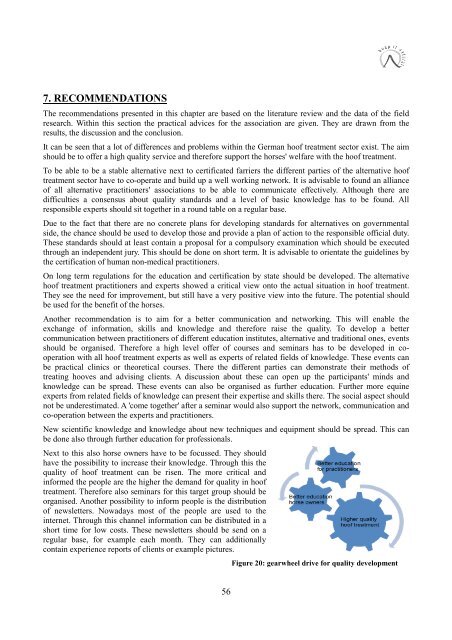Bachelor Thesis - Christina Kuenen - Hufpfleger
Bachelor Thesis - Christina Kuenen - Hufpfleger
Bachelor Thesis - Christina Kuenen - Hufpfleger
Create successful ePaper yourself
Turn your PDF publications into a flip-book with our unique Google optimized e-Paper software.
7. RECOMMENDATIONS<br />
The recommendations presented in this chapter are based on the literature review and the data of the field<br />
research. Within this section the practical advices for the association are given. They are drawn from the<br />
results, the discussion and the conclusion.<br />
It can be seen that a lot of differences and problems within the German hoof treatment sector exist. The aim<br />
should be to offer a high quality service and therefore support the horses' welfare with the hoof treatment.<br />
To be able to be a stable alternative next to certificated farriers the different parties of the alternative hoof<br />
treatment sector have to co-operate and build up a well working network. It is advisable to found an alliance<br />
of all alternative practitioners' associations to be able to communicate effectively. Although there are<br />
difficulties a consensus about quality standards and a level of basic knowledge has to be found. All<br />
responsible experts should sit together in a round table on a regular base.<br />
Due to the fact that there are no concrete plans for developing standards for alternatives on governmental<br />
side, the chance should be used to develop those and provide a plan of action to the responsible official duty.<br />
These standards should at least contain a proposal for a compulsory examination which should be executed<br />
through an independent jury. This should be done on short term. It is advisable to orientate the guidelines by<br />
the certification of human non-medical practitioners.<br />
On long term regulations for the education and certification by state should be developed. The alternative<br />
hoof treatment practitioners and experts showed a critical view onto the actual situation in hoof treatment.<br />
They see the need for improvement, but still have a very positive view into the future. The potential should<br />
be used for the benefit of the horses.<br />
Another recommendation is to aim for a better communication and networking. This will enable the<br />
exchange of information, skills and knowledge and therefore raise the quality. To develop a better<br />
communication between practitioners of different education institutes, alternative and traditional ones, events<br />
should be organised. Therefore a high level offer of courses and seminars has to be developed in cooperation<br />
with all hoof treatment experts as well as experts of related fields of knowledge. These events can<br />
be practical clinics or theoretical courses. There the different parties can demonstrate their methods of<br />
treating hooves and advising clients. A discussion about these can open up the participants' minds and<br />
knowledge can be spread. These events can also be organised as further education. Further more equine<br />
experts from related fields of knowledge can present their expertise and skills there. The social aspect should<br />
not be underestimated. A 'come together' after a seminar would also support the network, communication and<br />
co-operation between the experts and practitioners.<br />
New scientific knowledge and knowledge about new techniques and equipment should be spread. This can<br />
be done also through further education for professionals.<br />
Next to this also horse owners have to be focussed. They should<br />
have the possibility to increase their knowledge. Through this the<br />
quality of hoof treatment can be risen. The more critical and<br />
informed the people are the higher the demand for quality in hoof<br />
treatment. Therefore also seminars for this target group should be<br />
organised. Another possibility to inform people is the distribution<br />
of newsletters. Nowadays most of the people are used to the<br />
internet. Through this channel information can be distributed in a<br />
short time for low costs. These newsletters should be send on a<br />
regular base, for example each month. They can additionally<br />
contain experience reports of clients or example pictures.<br />
Figure 20: gearwheel drive for quality development<br />
56


